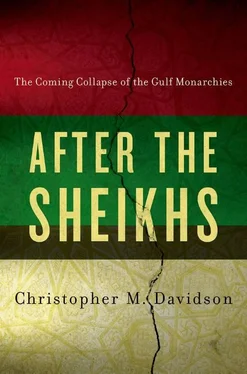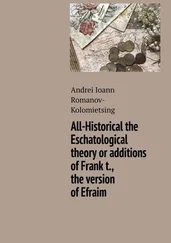32. Most notably American Standard Oil of New Jersey. Foreign Office 371/19975.
33. The Iraqi Petroleum Company was 51 per cent owned by the British Government. Foreign Office 371/19975.
34. Petroleum Concessions Ltd. was dominated by British Petroleum. See Hawley, Donald, The Emirates: Witness to a Metamorphosis (Norwich: Michael Russell, 2007), p. 67; Heard-Bey, Frauke, From Trucial States to United Arab Emirates (London: Longman, 1996), p. 295; and, ( in Arabic ) Al-Otaibi, Manna Said, Petroleum and the Economy of the United Arab Emirates (Kuwait: Al-Qabas Press, 1977), p. 45.
35. Al-Otaibi (1977), p. 155.
36. The first oil discoveries in Dubai were made in 1966 at the Fateh offshore field. See Butt, Gerald, ‘Oil and Gas’ in Al-Abed, Ibrahim and Hellyer, Peter (eds.), The United Arab Emirates: A New Perspective (London: Trident, 2001).
37. India Office l/P/S/18/B/458; Abdullah (1978), p. 70; Wilson (2006), p. 68.
38. India Office S/18/B/469.
39. India Office S/18/B/414.
40. The base was at Manama in Ajman. Hawley (2007), p. 278.
41. Muhammad bin Hamad Al-Sharqi.
42. Examples of these can still be viewed in the Fujairah museum.
43. Heard-Bey (1996), pp. 75–76; Hawley (2007). p. 113; Rush, Alan (ed.), Ruling Families of Arabia: The United Arab Emirates (Slough: Archive Editions, 1991), pp. 457–465.
44. Hawley (2007), p. 182.
45. The United Nations recognized Saudi Arabia in 1945.
46. Faisal bin Abdul-Aziz Al-Saud was assassinated by a nephew, Faisal bin Musaid Al-Saud. Faisal bin Musaid was declared insane by medical doctors, but was nonetheless beheaded later that year. BBC News, 25 March 1975.
47. Fahd bin Abdul-Aziz Al-Saud suffered a stroke in 1996 and handed over most duties to his crown prince and younger brother, Abdullah.
48. Obaid, Nawaf E., ‘The Power of Saudi Arabia’s Islamic Leaders’, Middle East Quarterly , Vol. 6, No. 3, 1999, pp. 51–58.
49. Hassner, Ron Eduard, War on Sacred Grounds (New York: Cornell University Press, 2009), p. 143.
50. Coates Ulrichsen, Kristian, ‘Saudi Arabia’ in Davidson (2011), p. 70.
51. Referring to the 1990 invasion of Kuwait by Iraq and the subsequent liberation of Kuwait by a US-led international coalition.
52. Nolan, Leigh, ‘Managing Reform? Saudi Arabia and the King’s Dilemma’, Brookings Doha Center Policy Briefing, May 2011.
53. Coates Ulrichsen, ‘Saudi Arabia’ in Davidson (2011), pp. 68–69.
54. See Herb, Michael, All in the Family: Absolutism, Revolution, and Democracy in the Middle Eastern Monarchies (New York: State University of New York Press, 1999).
55. Ibid., p. 70.
56. See Nolan, May 2011.
57. Coates Ulrichsen, ‘Saudi Arabia’ in Davidson (2011), p. 72.
58. Associated Press , 22 March 2011.
59. See Nolan, May 2011.
60. Coates Ulrichsen, ‘Saudi Arabia’ in Davidson (2011), p. 71.
61. See Nolan, May 2011.
62. US Department of State, ‘Background Note: Kuwait’ 2011.
63. Roberts (2011), p. 91.
64. Ibid., p. 93.
65. Ibid., pp. 93–94.
66. These ‘primaries’ were staged by a number of tribes between 1975 and 1998, when they were criminalised. See Salih, Kamal Eldin Osman, ‘Kuwait Primary (Tribal) Elections 1975–2008: An Evaluative Study’, British Journal of Middle East Studies , Vol. 38, No. 2, 2011, p. 142.
67. Roberts, p. 94.
68. Ibid., p. 94.
69. Ibid., p. 95.
70. On 16 May 2009 the voter turnout was 50 per cent. Kuwait Politics Database, Georgia State University 2011.
71. For a full discussion of the 2006 reforms see Salih, pp. 159–164.
72. The unpopular older brother being Shakhbut bin Sultan Al-Nahyan. See Davidson, Christopher M., Abu Dhabi: Oil and Beyond (London: Hurst, 2009), chapters 2–3.
73. Ibid., p. 99.
74. Davidson (2008), pp. 252–253.
75. Ibid., pp. 259–262.
76. Davidson (2005), chapter 1. The offer was rejected by the British government on the grounds that British armed forces could never be deployed as a mercenary force.
77. For a full discussion see Davidson (2009), chapter 3. Qatar also seemed to have hoped that the capital of the federation would be Doha. See Fromherz, Allen J., Qatar: A Modern History (London: IB Tauris, 2012), p. 18.
78. Comprising Abu Dhabi, Dubai, Sharjah, Ajman, Umm al-Qawain, and Fujairah.
79. Davidson (2009), pp. 56–61
80. Kinninmont, Jane. ‘Bahrain’ in Davidson, Christopher M. (ed.), Power and Politics in the Persian Gulf Monarchies (London: Hurst, 2011), pp. 37–38.
81. Ibid., p. 46. The mataams being the mourning houses for Imam Hussein bin Ali, a key Shia martyr and member of the Prophet Muhammad’s household.
82. Ibid., p. 43.
83. Ibid., p. 40.
84. Ibid., pp. 41–42.
85. Wright, Steven, ‘Qatar’ in Davidson, Christopher M. (ed.), Power and Politics in the Persian Gulf Monarchies (London: Hurst, 2011), p. 118.
86. Ibid., pp. 119–120.
87. Ibid., p. 120.
88. Ibid., p. 119.
89. Kamrava, Mehran, ‘Royal Factionalism and Political Liberalization in Qatar’, Middle East Journal , Vol. 63, No. 3, 2009, p. 416.
90. Ibid., p. 416.
91. Ibid., p. 417.
92. The Guardian , 1 November 2011.
93. For a full discussion see Davidson (2009). pp. 61–69.
94. See Al-Nabeh, Najat Abdullah, ‘United Arab Emirates: Regional and Global Dimensions’ (PhD thesis. Claremont Graduate School, 1984).
95. Article 49. See Al-Gurg, Easa Saleh, The Wells of Memory (London: John Murray, 1998), p. 140; Kéchichian, Joseph A., Power and Succession in Arab Monarchies: A Reference Guide (Boulder: Lynne Rienner, 2008), p. 284.
Читать дальше












